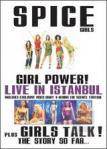
Last week I went to the NewFest film festival to see Grrrl Love and the Revolution, a documentary about the riot grrrl chapter in New York City in the early 90s. The film was made by Abby Moser, both a participant and an observer of Riot Grrrl NYC. Between 1993 and 1996 she shot footage of riot grrrl meetings, events, and concerts, and interviews with individual members. In 1998, two

The NYC riot grrrl chapter was started by several New Yorkers who attended the Riot Grrrl Convention in Washington, DC. in 1992 and were inspired to create their own group. The documentary also attributes the formation of riot grrrl groups to the straight,white, male domination of the punk scene, and the desire of many female musicians to create their own punk scene where they would feel welcome.
Soon after its founding, the group became one of the largest riot grrrl chapters in the country, with meetings often drawing up to fifty members. It was different from other riot grrrl groups in its large age range (from fifteen year-olds to thirty year-olds) and the large number of lesbian members.
The film charts the group’s growth in size and influence in the riot grrrl community as they produced zines, created exhibitions of members’ work, organized female rock shows, including a series of festivals called Pussy Stock, and met to discuss the issues facing women and the LGBT community.

Additionally, not all of the media interest was positive. A Time magazine cover article pronounced feminism as “dead” and Christian televangelist Pat Robertson claimed that feminism was a “socialist, anti-family political movement that encourages women to leave their husbands, kill their children, practice witchcraft, destroy capitalism and become lesbians.” The punk scene continued to be an often misogynistic and homophobic environment.
The group also faced issues of race and class in its later years, as it struggled to dispel the stereotype of feminists as white, middle-class, college-educated women and sought to encourage greater participation by minority groups. But these issues didn’t prevent

Riot grrrl NYC was an activist group, a feminist group, a LGBT group, but above all it was a community, where female artists and musicians supported each other and created together. The documentary does a wonderful job of capturing this sense of community and the power it had in inciting change.
I highly recommend that anyone interested in feminism and riot grrrl see this movie! It doesn’t look like they have anymore screenings planned for the immediate future, but you can check Girl Love and the Revolution’s twitter, facebook, and website for updates on future screenings. I’ll also post about them on Grrrl Beat if I hear about any!
